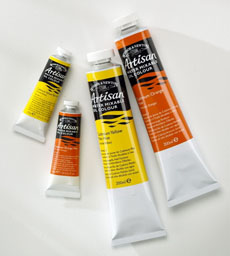Range Introduction
 Artisan Water Mixable Oil Colour has been specifically developed to appear and work just like conventional oil colour.
Artisan Water Mixable Oil Colour has been specifically developed to appear and work just like conventional oil colour.
The key difference between Artisan and conventional oils is its ability to thin and clean up with water. Hazardous solvents are not necessary for Artisan and artists can enjoy a safer painting environment, making it ideal for artists who share a work space, schools or painting at home.
The Artisan range consists of 40 colours and has a dedicated range of 11 Artisan solvents, oils, mediums and varnishes, allowing you to achieve all oil painting techniques.
 Sizes available
Sizes available
The Artisan range offers a balanced spectrum of 40 colours across two Series; Series 1 and Series 2. Both series are available in 37ml tubes, and 31 Series 1 colours are available in 200ml.
No Hazardous Solvents Required
Artists using conventional oil colour will require the use of solvents such as turpentine or white spirit (mineral spirits) for use when painting and for cleaning up their materials.
Artisan on the other hand can be thinned with water for painting and all brushes and equipment can be cleaned up with soap and water only.
This means that the use of hazardous solvents is not necessary with Artisan and as a result, artists can enjoy a safer painting environment. With this in mind, Artisan is ideal for:
- Oil painters who are sensitive to, or simply want to avoid exposure to solvents such as white spirit (mineral spirits) or turpentine.
- Students and teachers in schools and colleges where the use of oil colour is prohibited because of the solvents.
- Artists working in shared studio space where the build up of solvent levels could lead to a harmful concentration of vapours and a generally an unpleasant odour.
- Artists who work within a small home environment and wish to reduce the odour of oil painting.
- For travel, all Artisan products (Colour & Mediums) can be transported on aeroplanes (subject to the agreement of the airline).
Formulation
Winsor & Newton have 175 years of experience in the making of oil colours.
The choice of raw materials, formulation and manufacture of Artisan colours reflects this experience and produces a product of absolute excellence.
There is no water within the formulation of Artisan. The linseed oil and safflower oil vehicles have been modified to allow the colour to accept water, creating a stable emulsion, while retaining the working characteristics of conventional oil colour.
The range has also been formulated with a high proportion of single pigments for brilliance ofcolour andclean colour mixing. The most suitable oil and methods for dispersion have been selected to bring out the individual characteristics, from opacity to natural transparency, of each pigment in the Artisan range.
Pigments
A wide variety of pigments are used in Artisan to provide all the characteristics expected from a Winsor & Newton oil colour:
- High pigment strength & covering power
This provides good covering power, which is the ability of a pigment to either go a long way or cover previous layers.
- Variable Opacity
Winsor & Newton select the most suitable oil and method of pigment dispersion to bring out the individuality of each pigment in the Artisan range.
Opaque colours provide covering power and flat areas of colour whilst transparent colours give depth to the painting.
Widest spectrum
One of the greatest strengths of Winsor & Newton is the colour spectrum provided.
The Artisan colour range has been chosen according to mass tone (colour from the tube), undertone (bias of colour when in a thin film), strength and relative opacity. Each colour has been specially selected looking at individual pigment characteristics. The resultant colour spectrum of 40 colours is spread around the colour wheel to ensure that as many colour positions and mixtures are possible.
Colour Series
The series indicates the price of colour – mostly determined by the cost of obtaining and refining the pigment, e.g. Series 2 colours are more expensive as they contain genuine Cadmiums and Cobalts.
Viscosity/ Consistency
Artisan has the short buttery consistency expected from a Winsor & Newton oil colour, a consistency that is a careful balance between the pigment and the oils used in the formulation (modified linseed and safflower). This is the traditional consistency of oil colours, and as such allows the artist a broader variety of techniques, the colour can be thinned as required.
Surface Sheen
The reflective quality of the Artisan film is affected by a wide variety of factors. Because each pigment requires differing volumes of oil informulation, the surface sheen may differ slightly from colour to colour. The addition of water as a solvent, as well as the use of additive mediums will alter surface sheen as well.
Permanence
Most artists want to be sure that their colours are permanent. Recent pigment developments have led to continued improvements in the lightfastness of artists’ colours. These improvements have been utilised in Artisan. All Artisan colours are rated AA or A and are recommended as permanent for artists’ use.
Drying time
When Artisan is thinned with water, the water evaporates from the paint film fairly rapidly, leaving behind a conventional film of oil that dries by means of oxidation. The different drying rates of Artisan colours are due to the different reaction of each pigment when mixed with oil. Winsor & Newton formulate each colour individually to optimise its drying rate, helping artists to avoid the problems of slow drying underlayers. However, the following list is a guide to the likely variations:
Fast drying (around 2 days)
Prussian Blue, Umbers.
Medium Drying (around 5 days)
Cadmium Hues, Phthalo Blue (red shade) and Phthalo Greens, Siennas, French Ultramarine, Synthetic Iron Oxides, Ochres, Titanium White, Zinc White, Lamp Black, Ivory Black.
Slow drying (more than 5 days)
Cadmiums, Permanent Rose (quinacridone), Permanent Alizarin Crimson.